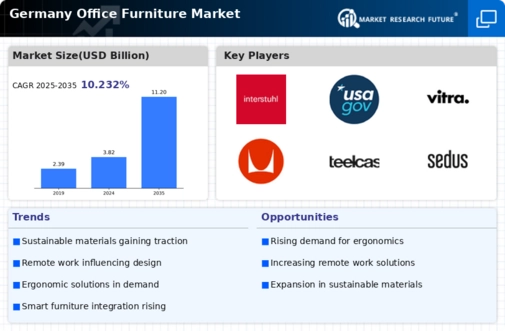Rising Demand for Ergonomic Solutions
The office furniture market in Germany experiences a notable increase in demand for ergonomic solutions. As awareness of workplace health and comfort grows, businesses are investing in furniture that promotes better posture and reduces strain. This trend is reflected in the market data, which indicates that ergonomic office chairs and desks have seen a sales increase of approximately 25% over the past year. Companies are recognizing that investing in employee well-being can lead to enhanced productivity and reduced absenteeism. Consequently, the office furniture market is adapting to meet these needs, with manufacturers focusing on innovative designs that prioritize ergonomics. This shift not only benefits employees but also aligns with corporate wellness initiatives, making ergonomic solutions a key driver in the office furniture market.
Shift Towards Flexible Work Environments
The office furniture market in Germany is significantly influenced by the shift towards flexible work environments. As organizations embrace hybrid work models, the demand for versatile furniture solutions is on the rise. This trend is evidenced by a 30% increase in sales of modular office furniture, which allows for easy reconfiguration of workspaces. Companies are seeking furniture that can adapt to various work styles, accommodating both collaborative and individual tasks. This flexibility is essential for fostering a dynamic workplace culture, which in turn enhances employee satisfaction and retention. The office furniture market is responding to this demand by offering a range of products that support adaptability, thereby positioning itself as a crucial player in the evolving landscape of work.
Sustainability as a Competitive Advantage
The office furniture market in Germany is increasingly influenced by sustainability as a competitive advantage. Companies are becoming more conscious of their environmental impact and are seeking furniture made from sustainable materials. Recent statistics indicate that sales of eco-friendly office furniture have risen by 35% over the last year, highlighting a shift in consumer preferences. Businesses are not only looking for aesthetically pleasing designs but also for products that align with their corporate social responsibility goals. This growing demand for sustainable options is prompting manufacturers to innovate and offer environmentally friendly solutions, thereby positioning themselves favorably in the office furniture market. As sustainability becomes a key differentiator, companies that prioritize eco-conscious practices are likely to gain a competitive edge.
Increased Investment in Office Renovations
The office furniture market in Germany is benefiting from increased investment in office renovations. Many companies are recognizing the importance of creating modern, inviting workspaces that reflect their brand identity. Recent data suggests that spending on office renovations has surged by 40% in the last year, driving demand for contemporary furniture solutions. This trend is particularly evident in urban areas, where businesses are competing to attract top talent by providing appealing work environments. As a result, the office furniture market is seeing a rise in demand for stylish, functional pieces that enhance the overall aesthetic of office spaces. This driver not only stimulates market growth but also encourages innovation among manufacturers to meet the evolving tastes of businesses.
Technological Advancements in Furniture Design
The office furniture market in Germany is increasingly shaped by technological advancements in furniture design. Innovations such as smart desks and integrated charging solutions are becoming more prevalent, reflecting a growing consumer preference for tech-savvy products. Market analysis indicates that the segment for technologically enhanced office furniture has expanded by 20% in the past year. These advancements not only improve functionality but also cater to the needs of a tech-oriented workforce. As companies seek to create efficient and modern workspaces, the integration of technology into furniture design emerges as a vital driver in the office furniture market. This trend encourages manufacturers to invest in research and development, ensuring that their offerings remain competitive and relevant.






















Leave a Comment